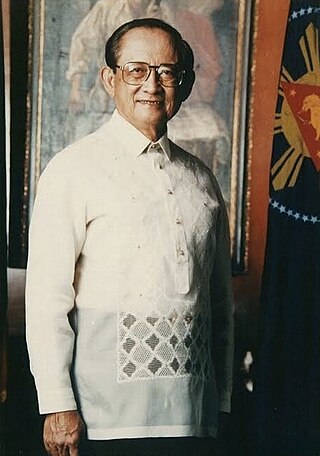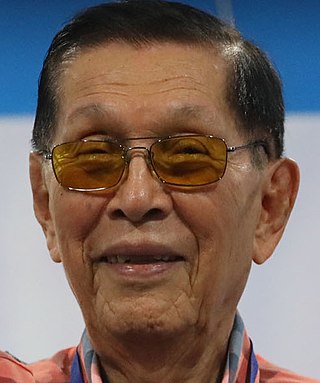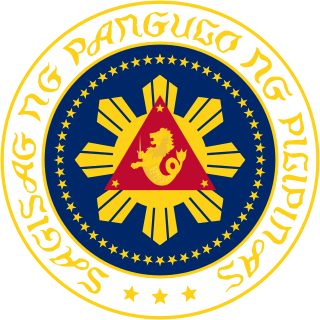
The People Power Revolution, also known as the EDSA Revolution or the February Revolution, was a series of popular demonstrations in the Philippines, mostly in Metro Manila, from February 22 to 25, 1986. There was a sustained campaign of civil resistance against regime violence and electoral fraud. The nonviolent revolution led to the departure of Ferdinand Marcos, the end of his 20-year dictatorship and the restoration of democracy in the Philippines.

Fidel Valdez Ramos, popularly known as FVR and Eddie Ramos, was a Filipino general and politician who served as the 12th President of the Philippines from 1992 to 1998. He was the only career military officer who reached the rank of five-star general/admiral de jure. Rising from second lieutenant to commander-in-chief of the armed forces, Ramos is credited for revitalizing and renewing international confidence in the Philippine economy during his six years in office.

Fabian Crisologo Ver was a Filipino military officer who served as the Commanding Officer of the Armed Forces of the Philippines under President Ferdinand Marcos.
Renato "Rene" Salud de Villa is a Filipino former police and military officer and government official. He served as Chief of Philippine Constabulary, Director-General of the Integrated National Police, and Chief of Staff of the Armed Forces of the Philippines. He then served as Secretary of National Defense under presidents Corazon Aquino and Fidel V. Ramos. He founded Partido para sa Demokratikong Reporma for his unsuccessful presidential bid in 1998. He then briefly served as Executive Secretary under President Gloria Macapagal Arroyo.

Juan Valentin Furagganan Ponce Enrile Sr.,, also referred to by his initials JPE, is a Filipino politician and lawyer known for his role in the administration of Philippine president Ferdinand Marcos; his role in the failed coup that helped hasten the 1986 People Power Revolution and the ouster of Marcos; and his tenure in the Philippine legislature in the years after the revolution. Enrile has served four terms in the Senate, in a total of twenty-two years, he holds the third longest-tenure in the history of the upper chamber. In 2022, at the age of 98, he returned to government office as the Chief Presidential Legal Counsel in the administration of President Bongbong Marcos.

Gregorio "Gringo" Ballesteros Honasan II, is a Filipino politician and a cashiered Philippine Army officer who led unsuccessful coups d'état against President Corazon Aquino. He played a key role in the 1986 EDSA Revolution that toppled President Ferdinand Marcos.

Proclamation No. 1081 was the document which contained formal proclamation of martial law in the Philippines by President Ferdinand Marcos, as announced to the public on September 23, 1972.

From 1986 to 1987, there were several plots to overthrow Philippine President Corazon Aquino involving various members of the Armed Forces of the Philippines. A significant number of the military participants in these attempts belonged to the Reform the Armed Forces Movement (RAM), while others were identified loyalists of former President Ferdinand Marcos, who had been deposed in the People Power Revolution in late February 1986.
The Reform the Armed Forces Movement, also referred to by the acronym RAM, was a cabal of officers of the Armed Forces of the Philippines (AFP) known for several attempts to seize power in the Philippines during the 1980s and 1990s. In 1986, some of these officers launched a failed coup d'état against Ferdinand Marcos, prompting a large number of civilians to attempt to prevent Marcos from wiping the RAM rebels out. This eventually snowballed into the 1986 People Power revolution which ended the dictatorship of Ferdinand Marcos and forced him into exile. RAM later attempted six coups d'état against the administration of Corazon Aquino.
Victor Batac was the former Director of the Directorate for Logistics of the Philippine National Police.
The People Power Revolution was a series of popular demonstrations in the Philippines that began in 1983 and culminated in 1986. The methods used amounted to a sustained campaign of civil resistance against regime violence and electoral fraud. This case of nonviolent revolution led to the toppling of dictator Ferdinand Marcos and the restoration of the country's democracy.

The 1990 Mindanao revolt was an uprising that occurred in parts of the island of Mindanao in the southern Philippines. It began when Alexander Noble, a dissident Philippine Army colonel linked to the 1989 Philippine coup attempt against President Corazon Aquino, and his supporters, which included Mindanaoan separatists, seized two military garrisons in Cagayan de Oro and Butuan without firing a shot and unilaterally proclaimed the independence of the Federal Republic of Mindanao on October 4, 1990, to be led by a civilian-military junta and with an ultimate goal of removing Aquino from office. However, Noble failed to gain support, and surrendered two days later following attacks by government forces. The revolt was the last overt attempt to overthrow Aquino's government until the end of her term in 1992.

Marites Dañguilan Vitug is a Filipina journalist and author who co-founded the news magazine Newsbreak. She was a Nieman Fellow at Harvard University from 1986 to 1987.
The alleged September 22, 1972, ambush attack on the then-Defense Minister of the Philippines Juan Ponce Enrile is a disputed incident in which Enrile's white Mercedes-Benz sedan was ambushed near the upscale Wack Wack village in Mandaluyong, Metro Manila. It was cited by President Ferdinand Marcos as the proximate incident which led to the announcement of Marcos' declaration of martial law the following day, although Marcos would later claim that he signed the formal proclamation of martial law on September 21, the day before the Enrile ambush.
The Military history of the Philippines during the presidency of Ferdinand Marcos, especially the 14-year period between Marcos' declaration of Martial Law in September 1972 and his final ouster through the People Power Revolution of 1986, was characterized by rapid changes linked to Marcos' use of the military as his "martial law implementor."
The February 1986 Reform the Armed Forces Movement coup was set in motion by the Reform the Armed Forces Movement (RAM) under the leadership of Defense Minister Juan Ponce Enrile to depose then-president Ferdinand Marcos, but was discovered and aborted in its earliest stages on February 22, 1986. The coup's intent was to take advantage of the public disruption arising from revelations of cheating during the 1986 Philippine presidential election, and replace Marcos with a military junta which would include Enrile, Philippine Constabulary Chief Fidel V. Ramos, then-Presidential Candidate Corazon Aquino, and Roman Catholic Cardinal Jaime Sin, among others, which Enrile and the RAM Colonels would control from behind the scenes.
On August 28, 1987, a coup d'état against the government of Philippine President Corazon Aquino was staged by members of the Armed Forces of the Philippines (AFP) belonging to the Reform the Armed Forces Movement (RAM) led by Colonel Gregorio Honasan, who had been a former top aide of ousted Defense Secretary Juan Ponce Enrile, one of the instigators of the People Power Revolution that brought Aquino to power in 1986. The coup was repelled by military forces loyal to Aquino within the day, although Honasan managed to escape.
The siege of the Manila Hotel was an occupation of the Manila Hotel, a luxury hotel in the Philippine capital Manila, led by former vice-presidential candidate Arturo Tolentino and other military and civilian supporters of deposed President Ferdinand Marcos as part of a coup attempt to overthrow his successor, Corazon Aquino and restore him to power, on 6–8 July 1986. The coup failed to gain extensive support, and ended on 8 July with the departure of most participants and the surrender of others.
The God Save the Queen Plot was a planned coup in November 1986 by Minister of National Defense Juan Ponce Enrile and the Reform the Armed Forces Movement (RAM), a dissident faction within the Armed Forces of the Philippines (AFP) to overthrow President Corazon Aquino, whom it helped install during the People Power Revolution nine months before. However, the staging of the coup was delayed and ultimately stopped by maneuvers within the AFP led by Chief of Staff General Fidel Ramos before a shot was even fired. As a result, Enrile was subsequently fired by Aquino from her cabinet.









